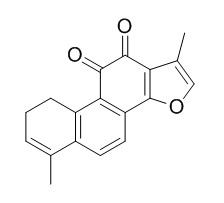1,2-Dihydrotanshinquinone
1,2 Dihydrotanshinquinone is active against both Trypanosoma brucei rhodesiense and Plasmodium falciparum.
Inquire / Order:
manager@chemfaces.com
Technical Inquiries:
service@chemfaces.com
Tel:
+86-27-84237783
Fax:
+86-27-84254680
Address:
1 Building, No. 83, CheCheng Rd., Wuhan Economic and Technological Development Zone, Wuhan, Hubei 430056, PRC
Providing storage is as stated on the product vial and the vial is kept tightly sealed, the product can be stored for up to
24 months(2-8C).
Wherever possible, you should prepare and use solutions on the same day. However, if you need to make up stock solutions in advance, we recommend that you store the solution as aliquots in tightly sealed vials at -20C. Generally, these will be useable for up to two weeks. Before use, and prior to opening the vial we recommend that you allow your product to equilibrate to room temperature for at least 1 hour.
Need more advice on solubility, usage and handling? Please email to: service@chemfaces.com
The packaging of the product may have turned upside down during transportation, resulting in the natural compounds adhering to the neck or cap of the vial. take the vial out of its packaging and gently shake to let the compounds fall to the bottom of the vial. for liquid products, centrifuge at 200-500 RPM to gather the liquid at the bottom of the vial. try to avoid loss or contamination during handling.
Bioorg Med Chem.2018, 26(14):4201-4208
Exp Biol Med (Maywood).2019, 244(16):1463-1474
Nutrients2022, 14(14)2929
Evid Based Complement Alternat Med.2021, 2021:8847358.
Hanoi University of Pharmacy2023, 14(1):30-39.
Evid Based Complement Alternat Med.2018, 2018:1073509
Biomolecules.2022, 12(12):1754.
Pharmaceuticals (Basel). 2021, 14(10):986.
Anticancer Res.2024, 44(3):1033-1044.
Plant Pathology2022, 10.1111:ppa.13651.
Related and Featured Products
Planta Med., 2011, 77(14):1594-6.
Antiplasmodial and antitrypanosomal activity of tanshinone-type diterpenoids from Salvia miltiorrhiza.[Pubmed:
21412700 ]
In a medium throughput screen of 880 plant and fungal extracts for antiprotozoal activity, a dichloromethane extract of Salvia miltiorrhiza roots was active against both Trypanosoma brucei rhodesiense and Plasmodium falciparum.
METHODS AND RESULTS:
With HPLC-based activity profiling in combination with on- and off-line spectroscopic methods (PDA, -MS (n), HR-MS, microprobe NMR), the active compounds were identified as tanshinone-type diterpenoids. Subsequent isolation and structure elucidation yielded the known substances miltirone (1), tanshinone II a (2), 1,2-Dihydrotanshinquinone(3), methylenetanshinquinone (4), 1-oxomiltirone (5), 11-hydroxymiltiodiol (6), tanshinone I (7), methyltanshinonate (8), and cryptotanshinone (9). The IC₅₀s of the compounds were determined against the two parasites and rat myoblast (L6) cells.
CONCLUSIONS:
They ranged from 4.1 μM to over 30 μM against P. falciparum K1 strain with selectivity indices (SI) from 0.3 to 1.9. IC₅₀s against T. brucei rhodesiense STIB 900 were from 0.5 μM (1, 4) to over 30 μM, and 4 showed the greatest selective activity with an SI of 24.



